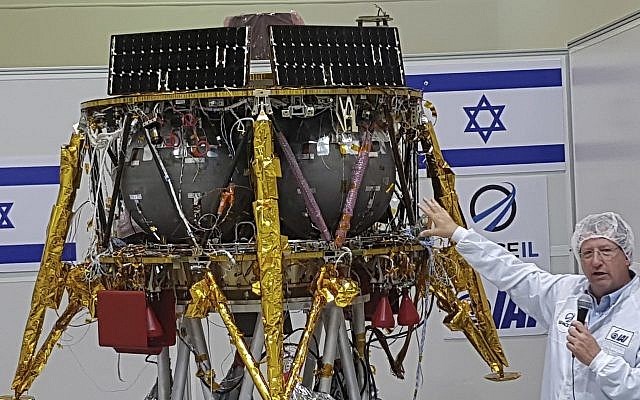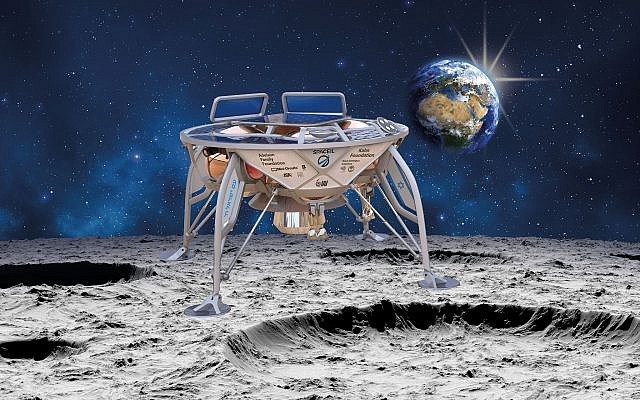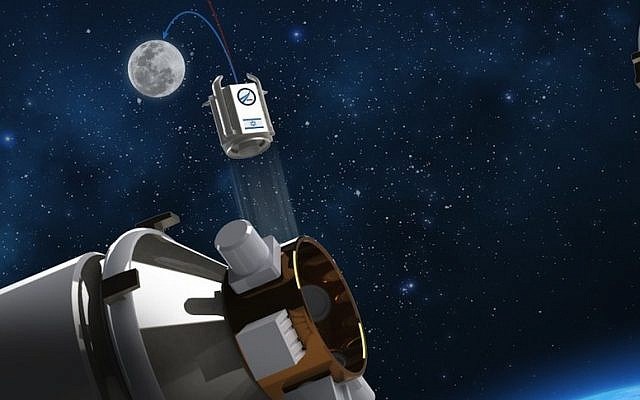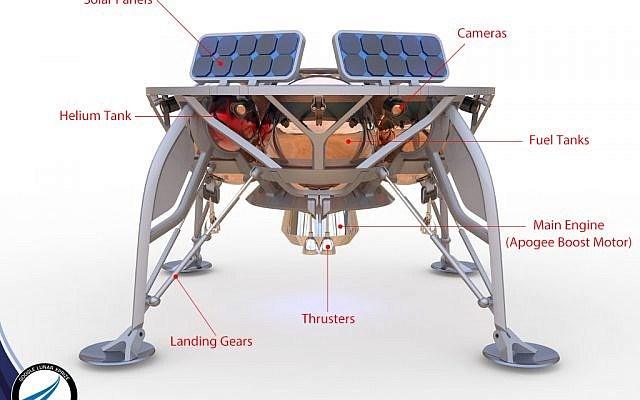
Opher Doron, general manager of Israel Aerospace Industries' space division, speaks beside the SpaceIL lunar module, in a special “clean room” where the space craft is being developed, during a press tour of their facility near Tel Aviv, Israel, July 10, 2018. (AP Photo/Ilan Ben Zion)
The Israel Space Agency said Wednesday that NASA had signed a deal with the SpaceIL group to help it launch a unmanned rocket at the moon in the coming months, in Israel’s first-ever moonshot.
SpaceIL, which is planning to launch the vehicle and land it on the moon on February 13, 2019, said NASA will provide a laser reflector that will help the spacecraft find a spot to land on the moon, as well as provide communications assistance.
The deal was signed in Germany during the 69th International Astronautical Congress.
“We all hope our spacecraft is just the first part and there will be more space missions and technological challenges to come,” SpaceIL head Ido Anteby said in a statement.
“The cooperation between Israel and the US is growing stronger in all areas, as is the partnership between NASA and the Israel Space Agency,” said Science Minister Ofir Akunis. “Israel is proud to be part of the renewed journey to the moon and to advance our technological capabilities everywhere.”
The agreement comes three months after NASA head Jim Bridenstine visited Israel and said he was looking to expand the agency’s relationship with the Jewish state.
If all goes well, the SpaceIL spider-like craft will give Israel entry into the exclusive club of just three nations that have so far achieved a controlled landing on the moon’s surface.
The probe will be launched sometime in December from Cape Canaveral aboard a SpaceX Falcon 9 rocket.
The project, begun seven years ago as part of a Google technology contest to land a small probe on the moon, was conducted together with Israel Aerospace Industries.

An illustration of the SpaceIL spacecraft on the moon (Courtesy)
The spacecraft will carry out a Weizmann Institute of Science experiment to measure the moon’s magnetic field, finishing its mission within two days.
SpaceIL’s vehicle is just two meters in diameter and 1.5 meters tall standing on its four legs. It weighs 600 kilograms, making it the smallest craft to touch down on the moon.
SpaceIL’s president, Israeli billionaire philanthropist Morris Kahn, donated some $27 million to the project.

An early 2013 artist’s rendering of the proposed orbit launch for the SpaceIL craft. (Courtesy)
Whereas other previous moonshot spacecraft have taken just days to reach their target, SpaceIL will be fired into an elliptical orbit to gradually bring it closer to the moon, a journey that will take two months but will save on carrying the fuel needed for a quicker passage.
Even so, the craft will travel at a speed that is 13 times faster than the maximal speed of an F-15 fighter jet as it steers itself to the moon, which is some 384,000 kilometers (239,000 miles) from Earth, about 10 times the distance between Earth and communication satellites orbiting it. Through its elliptical journey, the Israeli spacecraft will cover some 9 million kilometers, the project managers said.
The Falcon 9 launch rocket’s primary load will be a much a larger communications satellite.
The spacecraft’s design and development is all Israeli, the organizers said.

The SpaceIL moon landing craft. (SpaceIL)
The fuel is contained in balloon-like devices within the lightweight metal frame of the craft, with one engine at its center, and smaller engines on the side. The craft is equipped with solar panels, avionics, electronics and a control system – all of which were developed in Israel. It is also equipped with cameras and communication equipment so it can continuously be in touch with its operators on Earth.
Only the US has landed people on the moon, with the first human steps on the surface taken by Neil Armstrong on July 21, 1969, when he famously declared, “That’s one small step for man, one giant leap for mankind.”
